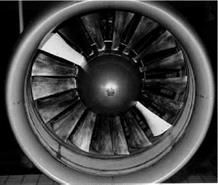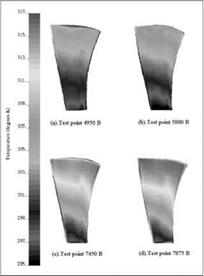CCD Camera Measurements
Using a CCD camera system, Bencic (1997, 1998) conducted full-field PSP and TSP measurements on rotating blades of a 24-inch diameter scale-model fan in the NASA Glenn 9×15 ft low speed wind tunnel at rotational speeds as high as 9500 rpm. PSP measurements with a CCD camera on high-speed rotating blades presented challenging problems, such as limited optical access to the entire surface of blades, very short light duration for sufficient illumination, detection of weak luminescence from high-speed rotating blades, and quantitative measurements without standard instrumentation for in-situ calibration of PSP.
A 25%-scale model fan used for experiments was a single rotation, ultra high bypass fan. Two blades were painted, one with a proprietary Boeing TSP and other with a Boeing PSP (PF2B) on a white primer basecoat. Figure 9.54 shows the painted fan blades installed 180° apart in the fan test rig. The traditional intensity-based method was used for both PSP and TSP, requiring two images for each of the paints to determine the pressure and temperature fields. Nine black targets were applied to both PSP and TSP painted blades for image registration. Both PSP and TSP were illuminated at wavelengths centered at 450 nm with multiple filtered and focused xenon flash quartz lamps with a 2-3 |j. s flash duration. The flash duration was short enough to freeze the motion of the blades with minimal blurring. Note that a 2-|j. s flash duration roughly corresponded to 0.5-mm blurring on blades at the highest speed.
|
Fig. 9.54. PSP and TSP painted blades mounted in an ultra-high bypass ratio fan rig. From Bencic (1997) |
Bencic (1997, 1998) used a 14-bit cooled scientific CCD camera (512×512 pixels) that was fitted with a 200-mm lens attached with a band-pass filter around 600 nm for both PSP and TSP. Image acquisition and pulsed excitation were synchronized with the position of the rig using a trigger signal from a magnetic speed sensor. Using a delayed trigger signal, blade motion could be stopped anywhere in a full rotation of 360o. Therefore, a PSP blade image was acquired
and then, by delaying the trigger signal in a 180o phase angle, a TSP image was taken since the PSP and TSP coated blades were installed 180o apart, as shown in Fig 9.54. Images were acquired and integrated over two hundred revolutions under excitation of multiple flashes while the camera shutter was kept open until achieving an acceptable CCD well capacity.
Two wind-off reference images and two data images of TSP and PSP were taken at each fan operating condition of interest. TSP images were used to correct the temperature effect of PSP. Figures 9.55 and 9.56 show, respectively, the temperature images and pressure images at the test points 4950B, 5800B, 7450B and 7875B that correspond to the speeds of 4950, 5800, 7450 and 7875 rpm, respectively. The surface temperature change on the blade was as large as 20oC under the operating conditions. TSP visualized flow separation occurred approximately at 75% span and 60% chord at the test points 7450B and 7875B.
|
Fig. 9.55. Temperature fields on the TSP-coated blade at four rig speeds of 4950, 5800, 7450 and 7875 rpm. From Bencic (1997) |
|
Fig. 9.56. Normalized pressure fields on the PSP-ccoated blade at four rig speeds of 4950, 5800, 7450 and 7875 rpm. From Bencic (1997) |














